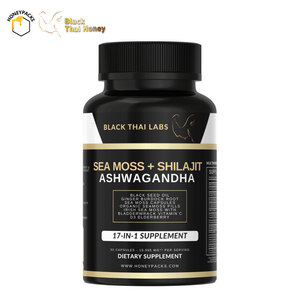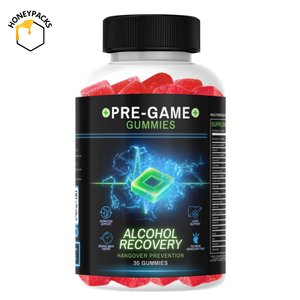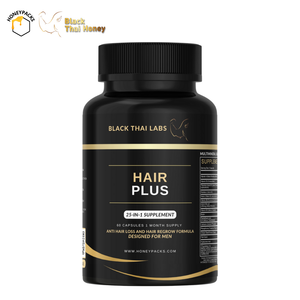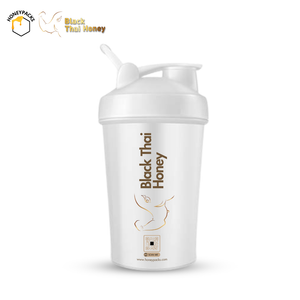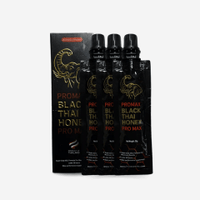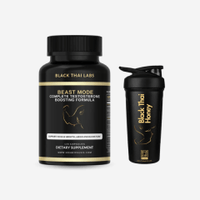Shelf Life Of Honey: How Long It Lasts And How To Store It
Honey never truly expires. Pure, sealed honey can stay safe to eat for decades, or even centuries, without spoiling. Crystallization, darkening, or texture changes are normal and don’t mean it’s gone bad. The only real threat to its longevity is moisture exposure.
Whether you’ve just unearthed an old jar in the back of your pantry, noticed your squeeze bottle thickening and changing color, or you’re buying in bulk for personal use or resale, this guide has you covered. Here's a quick snapshot of what you’ll learn:
- Why honey’s chemistry makes it virtually immortal
- How to tell if honey has actually gone bad (rare, but possible)
- What crystallization means, and how to reverse it
- How raw, pasteurized, and infused honeys compare in shelf life
- The truth about storing honey in plastic, the fridge, or your car
Honey Packs work with high-potency ingredients like black ginger, ginseng, and raw organic honey, for performance and purity. Our single-serve packs are shelf-stable, travel-ready, and packed with natural vitality, but even they need proper care to deliver long-term benefits.

If you want the full breakdown, how honey really works, what causes it to spoil (or not), and how to store it for years of quality, you’ll find it all below.
Does Honey Expire or Go Bad?
Honey is one of the few foods in the world that can last forever, and that’s not an exaggeration. Its chemistry is what makes it nearly immortal. With high natural sugar content, very low moisture, and an acidic pH (usually between 3.2 and 4.5), honey creates an environment where bacteria and fungi simply can’t survive. It’s nature’s built-in preservative system.
Bees play a key role too. During the honey-making process, they add enzymes, most notably glucose oxidase, which produce small amounts of hydrogen peroxide inside the honey. This gives it mild antibacterial properties, protecting it from spoilage even after years of storage.
Archaeologists have found jars of honey sealed inside Egyptian tombs dating back over 3,000 years, and when opened, the honey was still perfectly edible. That’s the same science that protects the honey sitting on your kitchen shelf right now.
So, can honey ever turn toxic or unsafe to eat?
Only if it’s contaminated by moisture. When water enters the jar (from a wet spoon, condensation, or improper sealing), yeast can activate, causing fermentation. You’ll know it’s spoiled if it smells sour, foams, or develops an alcohol-like odor. Otherwise, no matter how old it is, pure honey remains safe.
How Long Does Honey Last? Raw, Pasteurized, and Infused

Shelf Life of Raw Honey
Raw honey, minimally filtered and unheated, can last indefinitely if kept sealed and dry. Its natural enzymes and active compounds protect it from spoilage. However, raw honey is more prone to crystallization, where the sugars separate and form a grainy texture. This change is entirely natural and does not mean it’s gone bad. It’s simply the glucose molecules binding together over time.
Some believe raw honey spoils faster than pasteurized varieties because of its cloudy appearance or thicker texture. In truth, it just looks different, not spoiled. A warm water bath easily restores it to a liquid state without harming its nutrients.
Pasteurized Honey Shelf Life
Pasteurized honey, commonly found in supermarkets, undergoes heating to make it smoother and delay crystallization. While it tends to look fresher for longer, this process slightly reduces its nutrient density by breaking down some of the enzymes and antioxidants that make raw honey so valuable. Still, properly stored pasteurized honey also lasts for years without spoiling, its stability is nearly identical to raw honey.
Infused and Supplemented Honey
Honey infused with herbs, spices, or performance ingredients, like the black ginger, ginseng, and maca used in Honey Packs, can maintain a long shelf life as long as no moisture is introduced during preparation or storage.
The key is keeping every additive completely dry. For instance, dried ginger or herbal extracts blend safely into honey, but fresh or damp herbs can cause fermentation.
So, do ingredients like ginseng or black ginger affect honey’s longevity?
Only slightly, and only if improperly sealed. When prepared under the right conditions, infused honey remains shelf-stable for months or even years, making products like Honey Packs both potent and durable.
That said, single-serve formats should always be stored away from heat and moisture to maintain freshness and consistency.
Signs Honey Has Actually Gone Bad (Rare but Possible)
While true spoilage is rare, it’s important to know the signs.
If your honey smells sour, yeasty, or has a fermented, alcoholic scent, it’s no longer safe. Visible foam, bubbling, or a bulging lid are also red flags that fermentation has started, usually due to water contamination.
Mold is uncommon but possible when honey has been diluted or repeatedly exposed to humidity. Once this happens, it’s best to discard it.
And if you’re using portable or single-use products, such as honey-based performance packs, always inspect the packaging.
If a honey pack feels bloated or leaks, it’s safest to throw it away. Gas buildup often means fermentation has occurred inside, even if it still smells sweet.
Properly sealed and stored, though, honey is nearly indestructible, a testament to nature’s design and one of the reasons it remains a key ingredient in Honey Packs’ long-lasting natural formulas.
Crystallization, Darkening, and Texture Changes: Should You Worry?
Visual changes in honey often raise alarm bells, but the truth is, they’re completely normal and rarely a cause for concern. Understanding how and why honey shifts in appearance will save you from tossing out perfectly good product.
What Causes Crystallization?
Crystallization happens when the glucose in honey naturally separates from water, forming sugar crystals. This process is faster in raw honey because it retains more natural pollen, enzymes, and micronutrients, all of which act as seeds for crystals to form.
Cooler storage temperatures also accelerate crystallization. It’s a common mistake to store honey in the refrigerator, thinking it will preserve freshness. In reality, refrigeration speeds up the crystallization process significantly.
Crystallized honey is still completely safe to eat. In fact, it’s one of the most reliable signs that your honey is raw, real, and unfiltered.
How to Fix Crystallized Honey
If you prefer your honey smooth and pourable, a warm water bath is all you need. Submerge your honey jar (lid off) in a bowl of warm, not boiling, water and stir gently until the crystals dissolve.
Never microwave honey in plastic containers, especially not single-use honey packs like Honey Packs. Heating plastic at high temperatures can degrade the material, leach chemicals into the honey, or weaken the packaging itself.
Instead, warm your honey the traditional way: low, slow, and safe.
Does Crystallization Affect Benefits?
Not at all. Crystallized honey retains its full nutritional profile, including enzymes, antioxidants, and antibacterial properties. It’s still effective whether you’re using it as a natural sweetener, for skincare, or as part of your daily performance routine.
In fact, crystallization is often a mark of quality and authenticity, especially when it comes to natural products like Honey Packs, which use raw, unadulterated honey to preserve potency.
The Best Way to Store Honey for Maximum Shelf Life
Honey doesn’t need much to stay fresh, but small mistakes can shorten its lifespan or reduce its benefits. Here's how to store it properly.
Ideal Storage Conditions
Honey thrives in a cool, dry, and dark environment, ideally between 60–75°F. A kitchen cupboard away from heat sources is perfect. The most important rule? Keep it sealed. Air introduces moisture, which invites fermentation.
Use airtight containers to prevent exposure to humidity. Even trace amounts of water can change the entire composition of your honey over time.
Containers That Protect vs. Harm
Plastic may be convenient, but it’s far from ideal. Over time, plastic can absorb moisture and odors, compromising the purity and taste of your honey. It’s also more porous and less protective against heat or UV light.
Glass jars are your best bet. They maintain honey’s integrity, don’t leach chemicals, and help lock in flavor and consistency.
Yes, honey can absorb smells from nearby items. Storing it next to garlic, onions, or strong spices may taint its flavor. Choose a storage spot that’s scent-neutral.
Where Not to Store It
Skip the fridge. The cold not only speeds up crystallization, it can also affect the texture of infused honey blends. Avoid sunny windowsills too, exposure to direct light and fluctuating temperatures can degrade enzymes and antioxidants.
If you're using performance honeys or honey packs, don’t leave them in your car, especially in summer. High heat damages delicate ingredients like black ginger or maca, and could even affect the integrity of the packaging.
What About Opened or Half-Used Honey Packs?
If you’ve used part of a Honey Pack, reseal it tightly and keep it dry. The real danger lies in moisture getting trapped inside the nozzle or around the seal, which could kickstart fermentation.
A quick wipe and a tight closure can preserve the rest for another dose. Just be sure to use it soon, especially in warmer environments.
Does the Quality or Type of Honey Affect Shelf Life?

Yes, but not in the way most people think.
Raw honey, because it’s unfiltered and enzyme-rich, often looks more opaque or grainy, but this doesn’t mean it expires faster. On the contrary, its natural compounds can actually enhance its resilience.
Pasteurized honey might stay clearer longer, but that’s mainly for visual appeal. It’s been heated to delay crystallization, but this process also reduces beneficial enzymes and antioxidants.
Medicinal honeys, like Manuka, follow the same shelf-life rules. Their antibacterial properties remain stable when properly stored, though their price tag may encourage a little more careful handling.
There’s also a common misconception that organic or clean label honeys spoil faster. In reality, they last just as long as conventional honey, provided they’re properly sealed and free from moisture.
For a product like Honey Packs, the quality of the base honey, paired with clinical-grade herbs like black ginger, ensures both potency and shelf stability. You just need to keep it cool, sealed, and out of your gym bag on a hot day.
Extra Tips for Bulk Buyers and Honey Pack Users
Whether you’re stocking up for personal use, gifting, or keeping a stash for high-performance moments, how you store your honey matters, especially in single-serve formats like Honey Packs.
Here are a few simple but essential tips:
- Keep unopened packs in a dry pantry bin away from fluctuating temperatures and humidity. Airtight storage bins work best.
- If you're using honey for energy, stamina, or intimacy support, like with Honey Packs, avoid storing them near heat. Excess warmth can degrade sensitive ingredients like L-citrulline or maca extract. While honey naturally preserves these herbs, high heat may still reduce potency over time.
- You may have heard of people freezing honey packs to keep them fresh. While this isn’t necessary (thanks to honey’s natural preservation properties), doing so won’t harm the product. Just allow them to come to room temp before use.
- Avoid storing your packs in hot environments like cars, gym bags, or next to the stove. Constant heat exposure can degrade both the honey and the herbs inside, and may even lead to bloating or packaging issues.
- After opening, reseal and use Honey Packs promptly. Though honey protects itself well, any added moisture, especially in the nozzle, can compromise shelf life.
If you're serious about performance and want your natural products to work as intended, treat them with the same respect you would any other supplement. At Honey Packs, we design every pack for longevity, portability, and potency, but it’s up to you to store them right.

Conclusion
If your honey doesn’t smell sour, foam, or ferment, it’s still safe. Even if it’s darkened, thickened, or crystallized, those changes are signs of authenticity, not spoilage.
- Crystallization signals natural, real honey
- Dark color reflects natural aging, not spoilage
- Long shelf life is possible when honey is sealed and dry
Whether you’re drizzling it over breakfast or using it for performance support like our Honey Packs, the golden rule is to keep it cool, sealed, and away from moisture.
And when in doubt? Trust your senses. Honey has survived for millennia without preservatives or fancy packaging, and with the right care, your jar or pack will do the same.
